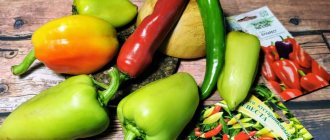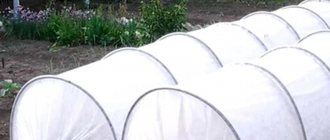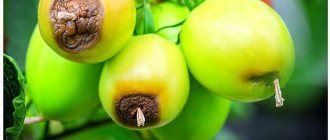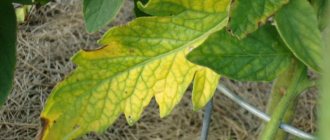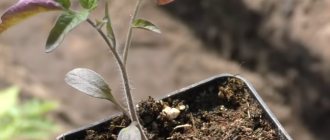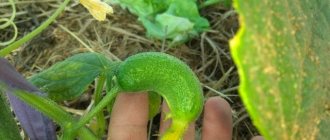Signs of poor seedling growth
You can tell that sweet pepper plantings are not growing well by their appearance. Common characteristics for all varieties:
- the leaves are small and faded, their number is less than that of healthy peppers;
- the stems are thinner than usual and more elongated, the color is not saturated;
- darkening at the roots;
- leaves may turn yellow and dry out;
- fruit deformities;
- the bushes look withered;
- the stems of the plant begin to bend;
- spots appear on the tops - dark or discolored, wet or dry;
All these symptoms indicate that the conditions created in the greenhouse were not very suitable for growing this demanding vegetable.
Important!
Peppers prefer moist air in a greenhouse and do not do well in dry air.
Diseases
As a rule, major (fungal) diseases plague peppers at the fruiting stage and rarely appear immediately after planting seedlings. If the bushes do not develop, and the leaves turn pale and wither, then these may be symptoms of Fusarium or Verticillium wilt. Deformation and curling of leaves (in the absence of insect pests such as aphids), contrasting yellow spots on them indicate viral infections.
What to do:
these diseases are incurable; the affected bushes must be dug up with a clod of earth and burned.
Main causes of poor growth
There are different reasons why peppers do not grow well. The development of vegetable crops is influenced by several significant factors. One of the most common is incorrect watering regime. Pepper is sensitive to lack of moisture. You need to moisten the soil every 2 days, otherwise the seedlings will die. Excess moisture is also harmful, leading to the development of pathogenic microorganisms and pests. Cold weather has a very negative effect on the condition of young bushes.
What to do
To combat the lack of moisture, after each watering, the rows are loosened and mulch is added . For intensive growth at each growing season, the crop is fed with organic and mineral fertilizers. In cold weather and in unfavorable climates, the bushes must be covered with film.
At the first signs of diseases and pests, plants are treated with special preparations.
How to treat: agrotechnical techniques
If peppers do not grow in the greenhouse after planting, it is important not to miss the moment and start treatment as soon as possible. Otherwise, there is a risk of being left without a harvest at all.
Simple agricultural techniques will help restore weakened seedlings. First of all, it is necessary to inspect the beds and remove all dead bushes so that they do not infect healthy ones. Peppers love heat very much, so the temperature should not fall below 23°C.
The lack of fresh air also harms plants; the greenhouse must be regularly ventilated. But drafts should not be allowed. Excessive density of plantings deprives them of the necessary sunlight. In this case, thinning of the seedlings is required. Water the seedlings correctly - often, but not too much, to prevent stagnation of water in the holes. It is useful to sometimes carry out root mulching.
Covering young animals with film
The greenhouse will protect young seedlings from cold and heavy rains. But after planting in open ground, they will need protection from the return of frost in the spring and cool night weather. Bell peppers do not tolerate temperature fluctuations well. For insulation, a film is usually used, which perfectly retains heat.
On hot days it must be removed, otherwise the plantings will overheat. The film can be completely removed in mid-June, after the temperature has completely stabilized. It is recommended to first install supports under the shelter. After all, fragile stems will not be able to withstand such weight.
Important!
Picking is unlikely to help strengthen a weak plant and can only worsen its condition due to damage to the roots.
Applying fertilizer to the soil
Caring for peppers necessarily involves adding fertilizer to the soil. Fertilizers stimulate the growth of seedlings and ensure a full harvest. You need to feed the bushes in accordance with the scheme developed by specialists. Organic substances are added to the soil 2 weeks after planting in the greenhouse. There is no need to do this before.
For this purpose, you can use fermented manure or bird droppings diluted in water. After the same period of time, mineral mixtures are used. To prepare 10 liters of water, take 40 g of superphosphate and ammonium nitrate, to which 20 g of potassium sulfate are added.
Traditional methods of helping weak pepper seedlings
When pepper seedlings do not grow and begin to wither, traditional methods of treating them help. They are actively used by opponents of industrially produced chemicals. Wood ash as a fertilizer reliably protects the grown peppers from pests and improves the composition of the soil. Ash sprinkled around each bush will stop the growth of weeds and the spread of dangerous microbes, retain moisture in the soil and level out its acidity.
Folk remedies
Along with drugs, summer residents use traditional methods to combat pests and viral or bacterial infections. For example, to accelerate growth, fertilize using tea leaves. A glass of used tea leaves is diluted with 3 liters of water. The tincture settles for 5 days and water the plants evenly.
Mix in a ratio of 30:60 g:
- yeast;
- granulated sugar.
The mixture is poured with a liter of water above room temperature and the solution is poured onto the soil near the root. The response to the drug is observed from the third day onwards.
You can make fertilizer from ash by sprinkling it around the bushes. It retains moisture in the soil, preventing weeds from germinating. Normalizes acidity, repels pests and suppresses pathogenic viruses or bacteria.
Nuances when growing vegetables in greenhouse conditions
Peppers sometimes wither in a greenhouse due to ignorance of the peculiarities associated with growing vegetables in protected soil. The best predecessors for pampered crops are carrots, cucumbers and onions. It should not be planted after tomatoes and potatoes. This is due to the presence of common diseases and pests in these plants. Before transplanting seedlings, the soil must be disinfected using a solution of copper sulfate. This will protect the plantings from possible infection.
Many people are interested in what to do when pepper seedlings grow poorly. It must be remembered that on sunny days it can be too hot in the greenhouse. For seedlings to grow strong and healthy, they need an influx of fresh, but not cold air. It would be a bad idea to keep representatives of different varieties close together in a greenhouse. Seedlings must be protected from cross-pollination.
Important!
Nitrogen is deposited in fruits, so it is not used during fruiting.
Resumption of development
After identifying the main obstacles to the growth of pepper, you can move on to eliminating these problems. Do not use garden black soil because of its density. Add raising agents to the soil: peat, Perlite, etc.
The liquid will go straight into the plant. The measure will allow the roots to breathe. As soon as you have watered, loosen the soil. Do not damage the pepper roots that are near the surface. This will prevent weeds from appearing in the future.
- Adjusting light and heat. Create the optimal temperature for pepper growth. There should also be a reasonable amount of light. If there is an excess of it, the seedlings will become excessively elongated and die. The lack of light is minimized by special lamps.
- Behavior after a pick. You should not perform this procedure too early or late. Plants experience discomfort when transplanted. Fertilizers and fertilizing will help improve the situation.
- Helping pepper with excess nutrition. Stop feeding the seedlings. Excess substances will go deep into the bud, and the seedlings will return to normal growth.
- Stop the pests. Protecting the plant from pests is important. Treat with special preparations. It is better to do this in the evening, because during the day the sun's rays hitting the wet leaves of the plant can create stress for them.
Improper cultivation of seedlings
Peppers also wilt even when the seedlings were grown incorrectly. The time for sowing seeds is chosen depending on the ripening speed of a particular variety. Early ripening plants need 8 weeks before planting in the greenhouse, while later ripening plants need at least 10 weeks. If you sow peppers too early, the seedlings will overgrow and will not be able to take root.
This vegetable crop is light-loving. Obtaining viable seedlings is impossible without a sufficient amount of light, so it is useful to use additional light sources, extending the daylight hours to 10-12 hours. For intensive growth, seedlings need frequent watering, for which only warm water can be used.
Sun influence
Peppers do not grow if the process of photosynthesis in the leaves is disrupted.
Burns
Freshly planted seedlings exposed to direct sunlight may get burned. At the same time, the leaf plates lighten or shrivel, up to partial or complete death.
What to do:
- you need to immediately treat the plants with Zircon and cover them with agrofibre for several days;
- The cover should be removed in cloudy weather.
Lack of light
Peppers planted too densely or in a shaded area suffer from lack of light.
What to do:
- thin out dense plantings so that the bushes do not shade each other;
- remove an external source of strong shade or urgently transplant the peppers to a brighter place.
Why are fertilizers needed?
If peppers do not grow in a greenhouse, you need to make sure that the soil is sufficiently fertile. Nutrient deficiency is especially detrimental to plants during the growing season. Bushes noticeably weaken with a lack of nitrogen, phosphorus and potassium. In this case, the foliage often curls and becomes deformed. Timely application of fertilizing in the form of aqueous solutions will help correct the situation.
Without this, it will not be possible to obtain a normal harvest, and the quality of the fruit will not be the best. However, not only a lack of fertilizers is harmful, but also their excess, which leads to growth inhibition. Nitrogen helps to grow green mass, and phosphorus strengthens the roots and accelerates the ripening of fruits.
Important!
Seedlings cannot be transplanted into the greenhouse until the soil in it warms up to 15°C at a depth of 10 cm.
Fear of cold
Cold is one of the most common factors in plant failure. Pepper needs warmth. Optimal numbers during the day are +25 degrees, at night +10-12C. If this factor is not taken into account, then the root system will be the first to suffer, which will lead to the death of the pepper.
Shoots begin to appear towards the end of February and beginning of March. Gardeners recommend placing seedlings in a lighted place. Covering with film or canvas will help cope with the cold. Not enough heat and the pepper will stop developing. You should protect yourself by creating arches in the greenhouse in case of frost.
Basic plastic bottles are suitable for saving plants on the ground. Take care of heat sources in the form of stones. They should be left in the sun in advance so that they warm up and then release positive temperatures to the soil in the dark. This method is extremely beneficial for pepper roots.
How to properly fertilize
It is very important to alternate organic substances with mineral ones. The amount of fertilizer should initially be small, but gradually increase it. Fresh manure cannot be used, because... it generates too much heat during decomposition and will burn the plant roots. Any fertilizing should be applied only to moist soil. Therefore, the best time would be the third day after heavy watering.
The addition of superphosphate promotes fruit set as quickly as possible. The roots slowly absorb nutrients. Therefore, a faster way to support plantings would be foliar feeding. It involves the absorption of necessary elements by leaves and stems. Almost instant results are guaranteed. They choose to conduct it in the morning or evening, when there is no scorching sun. Spray not only the outside, but also the inside of the leaf.
Fertilizer application methods
Farmers use several feeding methods (separately and in combination, simultaneously):
- To improve fertility, the site is fertilized when digging in the fall or early spring.
- Supporters of natural agricultural technology sow green manure in the fall before winter in order to saturate the soil. In the spring, when digging, the fermented remains of green fertilizers are embedded in the soil.
- Root feeding is applied through watering and mulching with lawn grass and green manure.
- Foliar (by leaf) is carried out through sprinkling, irrigation and spraying.
Prevention measures
Preventive measures increase the productivity of plantings and reduce the likelihood of their death. When watering, water should be poured at the root so as not to touch the tops. After watering, the soil is loosened to provide oxygen and prevent the formation of crust. Damaged fruits must be removed to prevent damage by fungal spores. Nightshades are most often susceptible to late blight. As a preventive measure, planting material is treated with a manganese solution. Diseased plants can be sprayed with “Ordan” or “Fitosporin-M” before flowering begins. Blackleg affects the root system of seedlings. Its cause is increased humidity and too close proximity of bushes.
The most common pests that live on peppers are spider mites, aphids and cutworms. Plantings can be treated with insecticides, but it is better to do without chemicals. You can avoid the infestation of parasites with the help of natural infusions of onions, calendula or pine needles. Some people prefer washing with soapy water or fumigating with tobacco smoke.
Important!
To attract pollinating insects to the greenhouse, it is recommended to spray the bushes with a sweet solution.
When growing peppers in a greenhouse or in open ground, you need to try to provide them with suitable conditions. Only proper care will allow you to preserve the seedlings, growing healthy plants with strong immunity. To increase yields, it is useful to use proven agrotechnical techniques.
Insect pests
Urgent problems include pests that parasitize plants and slow down their growth. List of insects that can affect the growth of bushes:
- aphid;
- spider mite;
- slugs;
- Colorado potato beetle, its larvae;
- May beetle, its larvae;
- whiteflies.
We need a comprehensive fight against harmful insects, namely treating the damaged area with insecticides. The modern market provides drugs with a broad effect or specifically against a particular type of parasite.
When is it not necessary to feed?
Attention! If the upper leaves are lighter than the main above-ground part, it means that the pepper is doing well and has sufficient nutrition.
From the moment the buds appear, it is important to strictly adhere to the dosage of nitrogen fertilizers. Saturation with nitrogen is fraught with consequences - the plant will drop its buds. Naturally, there can be no question of any pepper harvest. The buds are not restored.
By the way, overfeeding eggplants and tomatoes with nitrogen is not as bad as peppers.
